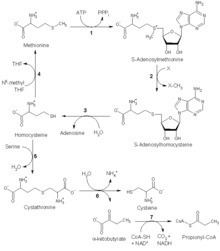Formula C4H9NO2S Appearance White crystalline powder | Molar mass 135.18 g/mol | |
 | ||
IUPAC ID 2-Amino-4-sulfanylbutanoic acid | ||
Homocysteine blood test and risks of cardiovascular diseases
Homocysteine /ˌhoʊmoʊˈsɪstiːn/ is a non-protein α-amino acid. It is a homologue of the amino acid cysteine, differing by an additional methylene bridge (-CH2-). It is biosynthesized from methionine by the removal of its terminal Cε methyl group. Homocysteine can be recycled into methionine or converted into cysteine with the aid of certain B-vitamins.
Contents
- Homocysteine blood test and risks of cardiovascular diseases
- What is homocysteine
- Structure
- Biosynthesis and biochemical roles
- Biosynthesis of cysteine
- Methionine salvage
- Other reactions of biochemical significance
- Homocysteine levels
- Elevated homocysteine
- References
A high level of homocysteine in the blood (hyperhomocysteinemia) makes a person more prone to endothelial cell injury, which leads to inflammation in the blood vessels, which in turn may lead to atherogenesis, which can result in ischemic injury. Hyperhomocysteinemia is therefore a possible risk factor for coronary artery disease. Coronary artery disease occurs when an atherosclerotic plaque blocks blood flow to the coronary arteries, which supply the heart with oxygenated blood.
Hyperhomocysteinemia has been correlated with the occurrence of blood clots, heart attacks and strokes, though it is unclear whether hyperhomocysteinemia is an independent risk factor for these conditions. Hyperhomoscyteinemia has also been associated with early pregnancy loss and with neural tube defects.
What is homocysteine
Structure
Homocysteine exists at neutral pH values as a zwitterion.
Biosynthesis and biochemical roles
Homocysteine is not obtained from the diet. Instead, it is biosynthesized from methionine via a multi-step process. First, methionine receives an adenosine group from ATP, a reaction catalyzed by S-adenosyl-methionine synthetase, to give S-adenosyl methionine (SAM). SAM then transfers the methyl group to an acceptor molecule, (e.g., norepinephrine as an acceptor during epinephrine synthesis, DNA methyltransferase as an intermediate acceptor in the process of DNA methylation). The adenosine is then hydrolyzed to yield L-homocysteine. L-Homocysteine has two primary fates: conversion via tetrahydrofolate (THF) back into L-methionine or conversion to L-cysteine.
Biosynthesis of cysteine
Mammals biosynthesize the amino acid cysteine via homocysteine. Cystathionine β-synthase catalyses the condensation of homocysteine and serine to give cystathionine. This reaction uses pyridoxine (vitamin B6) as a cofactor. Cystathionine γ-lyase then converts this double amino acid to cysteine, ammonia, and α-ketobutyrate. Bacteria and plants rely on a different pathway to produce cysteine, relying on O-acetylserine.
Methionine salvage
Homocysteine can be recycled into methionine. This process uses N5-methyl tetrahydrofolate as the methyl donor and cobalamin (vitamin B12)-related enzymes. More detail on these enzymes can be found in the article for methionine synthase.
Other reactions of biochemical significance
Homocysteine can cyclize to give homocysteine thiolactone, a five-membered heterocycle. Because of this "self-looping" reaction, homocysteine-containing peptides tend to cleave themselves by reactions generating oxidative stress.
Homocysteine also acts as an allosteric antagonist at Dopamine D2 receptors.
Homocysteine levels
Homocysteine levels are typically higher in men than women, and increase with age.
Common levels in Western populations are 10 to 12 μmol/L, and levels of 20 μmol/L are found in populations with low B-vitamin intakes or in the older elderly (e.g., Rotterdam, Framingham).
The ranges above are provided as examples only; test results should always be interpreted using the range provided by the laboratory that produced the result.
Elevated homocysteine
Abnormally high levels of homocysteine in the serum, above 15 µmol/L, are a medical condition called hyperhomocysteinemia. This has been claimed to be a significant risk factor for the development of a wide range of diseases, including thrombosis, neuropsychiatric illness, and fractures. It is also found to be associated with microalbuminuria which is a strong indicator of the risk of future cardiovascular disease and renal dysfunction.
Additionally, elevated homocystine is found in megaloblastic anemia.
